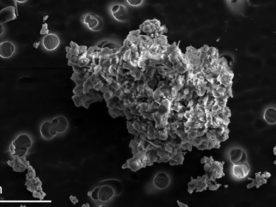Scientists have long been puzzled by a mysterious formation located near the equator of Mars called Medusae Fossae.
A new study from a pair of scientists – Lujendra Ojha and Kevin Lewis – at the Johns Hopkins University in Baltimore suggests that the large deposit of soft rock was probably formed as a result of violent volcanic eruptions that blasted fountains of hot ash, rock, and gas into the sky some 3 billion years ago.

A 13-kilometer diameter crater being infilled by the Medusae Fossae Formation.
(High-Resolution Stereo Camera/European Space Agency)
According to the lead author of the study, Lujendra Ojha, a planetary scientist at Johns Hopkins University, the eruptions could have also pumped out enormous amounts of climate-changing gases into the Martian atmosphere and expelled an amount of water that would have covered the Red Planet with a global ocean more than 9 centimeters deep.
These toxic greenhouse gases, such as hydrogen sulfide and sulfur dioxide, according to the study, would have changed the chemistry of the surface and atmosphere of Mars, affecting the planet’s potential for habitability.
The study detailing the scientist’s findings have been published in the Journal of Geophysical Research: Planets, which is a journal of the American Geophysical Union.
























Comments are closed.